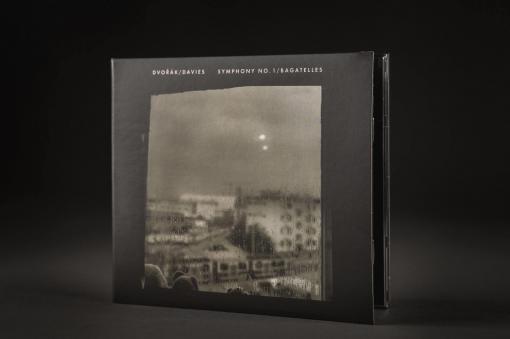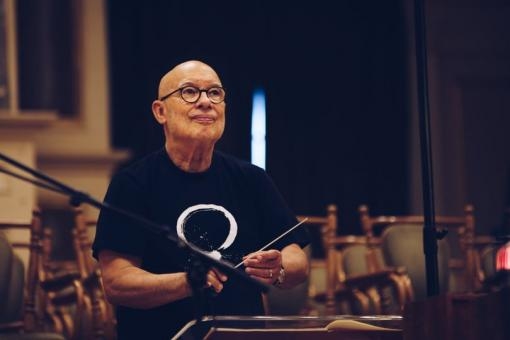With the current epidemiologic situation and the impossibility of live concerts, many large and small ensembles have been using the time to prepare new media. One of them is the Brno Philharmonic, which has extended its range to include its own edition of CD recordings with this bold motto: “Music you can hardly buy anywhere else”. Although it might seem that this is, primarily, a successful slogan created by the Marketing Department this brief description is not merely empty words. The first pair of CDs released at the end of 2020 offered the unfairly forgotten oratorio Lenora (Lenore) by Antonín Rejcha (heard at concerts on 5, 6 and 7 February, 2020). The philharmonic orchestra also recorded a programme with Dvořák’s Symphony No. 1 in C minor, Zlonické zvony (The Bells of Zlonice) and the composition entitled Bagatelles, Op. 47, (Maličkosti (Trivia)) both adapted (and in the case of Bagatelles also with richer instrumentation) by the chief conductor of the Brno Philharmonic, Dennis Russell Davies. And this is the album which will be the object of our evaluation.
As with Rejcha’s Lenora, listeners have already had an opportunity to listen to the two compositions from Dvořák’s album: Symphony No. 1, Zlonické zvony at the chief conductor’s inauguration concert and Bagatelles at the subscriber’s evening in January last year. Both works were given a new look by Davies. The conductor has tried to “fine-tune” the First Symphony by Dvořák structurally and instrumentally from the position of an older colleague (at the time of the composition Dvořák was only 24 years old). Bagatelles by the chief conductor is then more of a chamber composition – the work was originally intended for two violins, a violoncello and a pump organ – in an orchestral guise.
Dvořák's First Symphony is probably the only one of the composer's works that has not undergone an author's revision (his score was not discovered until 1923). Of course, some compositional procedures do not reach the elegance of the composer’s later works. Nevertheless, the symphony cannot be denied the melodic freshness and fierce creativity typical of Dvořák's musical language. Davies’ interventions are mainly of a structural nature and many deletions are more extensive than is customary with similar adaptations. The tempos will be a great surprise for listeners used to, for example, the well-regarded performance by the London Symphony Orchestra – Davies prefers a rather slow and less energetic performance at the beginning, which through a vaulted arch leads to a more distant point. The composition is thus a bit sweeter. If it manages to appeal to its listeners because of its great dynamic arc and keeps them full of excitement, it is somewhat more powerful at the same time; however, there is a danger that it will lose many smaller peaks on the way and will simply be too protracted. The recording has a relatively marked dynamic space, not ruined by excessive compression, so the peaks have the required grandiose effect and the pianissimos caress with its softness. Moreover, the orchestra performs in excellent harmony and with feeling for Davies’ interpretative grasp. It is definitely not possible to highlight one group of players at the expense of others; great performances permeate the entire ensemble.

Davies has definitely succeeded in transforming the chamber Bagatelles into an orchestral work. The composition has kept its complete form and its richer instrumentation really only serves the music itself, without degrading to mere spectacular tinsel. Davies does not stray far from the chamber character of the original – solo instruments often start individual parts or emerge from the orchestral sound at excellently selected points again. Davies’ adaptation is more a merging of the orchestral and chamber principles than an orchestral work with solo parts. The music excels in impressiveness and intimacy, objectivity and subjectivity. These moments pervade the composition in their continuously developing struggle and reconciliation. Moreover, sudden entries of solo instruments surprisingly restrain the sentiment that is markedly impassioned here and there. A separate chapter consists of wind instruments among which Davies wrote the harmonium from the original cast. A flute, two oboes, a clarinet, two bassoons and two French horns veil the original Dvořák melodies in a sweet and more colourful sound. The peaks that were made points by Davies are supported by this new instrumentation and the gradation at the beginning of the last minute of the last sentence, which is followed by gradual calming, excellently closes not only the composition, but also the whole album.
The new CD by the Brno Philharmonic offers a non-traditional, but remarkable and in many respects very successful interpretation of two works by Antonín Dvořák. The album is also presented with high quality sound and refined interpretative performances. There is no reason not to recommend the latest recording under the baton of Dennis Russell Davies. Moreover, this is really “Music that you can hardly buy anywhere else”.
Brno Philharmonic
Conductor: Dennis Russell Davies
Recorded at Besední dům (the Community Hall) in Brno in June 2020.
Recording director, sound engineer, post-production: Jaroslav Zouhar
Production: Pavlína Sládková, Pavel Šindelář
Cover photo: Vojtěch V. Sláma
Photos: Vojtěch Kába
Graphic design and typesetting: Petr Tejkal
Made in the Czech Republic by the Brno Philharmonic
































No comment added yet..